Source: https://www.time-to-change.org.uk/category/blog/talking-about-mental-health
art student
• 1 in 4 people experience mental health issues each year
• 676 million people are affected by mental health issues worldwide
• Mental illness is the largest single source of burden of disease in the UK. Mental illnesses are more common, long-lasting and impactful than other health conditions
• 70-75% of people with diagnosable mental illness receive no treatment at all
• Over a third of the public think people with a mental health issue are likely to be violent but people with severe mental illness are more likely to be the victims, rather than the perpetrators, of violent crime
• About 20% of young people with mental ill health wait more than six months to receive care from a specialist
• Between 4% and 15% of people meet the diagnostic criteria for personality disorder
Source: https://mhfaengland.org/mhfa-centre/research-and-evaluation/mental-health-statistics/
• Borderline personality disorder – 2.4 in 100 people
• Reports from both England [2] and Wales [3] suggest that approximately 1 in 8 adults with a mental health problem are currently receiving treatment. Medication is reported as the most common type of treatment for a mental health problem
Source: https://www.mind.org.uk/information-support/types-of-mental-health-problems/statistics-and-facts-about-mental-health/key-facts-and-trends/
• There is a strong social stigma attached to mental ill health, and people with mental health problems can experience discrimination in all aspects of their lives.
• Many people’s problems are made worse by the stigma and discrimination they experience – from society, but also from families, friends and employers.
• Nearly nine out of ten people with mental health problems say that stigma and discrimination have a negative effect on their lives.
• Society in general has stereotyped views about mental illness and how it affects people. Many people believe that people with mental ill health are violent and dangerous, when in fact they are more at risk of being attacked or harming themselves than harming other people.
• The situation is exacerbated by the media. Media reports often link mental illness with violence, or portray people with mental health problems as dangerous, criminal, evil, or very disabled and unable to live normal, fulfilled lives.
• This is far from the case.
• Research shows that the best way to challenge these stereotypes is through firsthand contact with people with experience of mental health problems. A number of national and local campaigns are trying to change public attitudes to mental illness. These include the national voluntary sector campaign Time to Change.
• The Equality Act 2010 makes it illegal to discriminate directly or indirectly against people with mental health problems in public services and functions, access to premises, work, education, associations and transport.
Source: https://www.mentalhealth.org.uk/a-to-z/s/stigma-and-discrimination
Source: https://www.time-to-change.org.uk/category/blog/talking-about-mental-health
• We all have a brain. If it was called brain health, would have the same stigma and discrimination? What if mental health was visible and left a unique mark to each person? Would people be kinder or still presume to know what’s going on inside?
• Imagine you’ve broken your leg, then you would go to see a doctor. They give you a leaflet and put you down on a six months’ waiting list. You wait six months to then be told it might be two years before you’re seen. You’d agree that it is unacceptable. But when it comes to mental health, this is often the process we have to follow.
Source: https://www.ukyouth.org/2018/05/14/stop-mental-health-stigma-and-discrimination/?gclid=EAIaIQobChMIwPyyzdqw5wIVzLTtCh1xLgEwEAAYAiAAEgIHBfD_BwE
So many people suffer from mental illness, yet because of stigma and misinformation, there are still so many afraid to come forward with their problems and start up a conversation. I want my art to open up a dialogue to those it reaches, talking is such an important first step to getting over/ living with mental illness and its still such a difficult topic. I want more people to come forward with their own experiences, if we normalise mental illness more, and educate people about them- it would be a less scary subject.


The next symptom is Dissociation. Dissociation is a break in how your mind handles information. You may feel disconnected from your thoughts, feelings, memories, and surroundings. It can affect your sense of identity and your perception of time. The symptoms often go away on their own. It can feel like an out of body experience or like you’re in a thick bubble.
I am particularly proud of this illustration, and my ability to depict this phenomenon. I have not seen any other pictorial representations of dissociation and I pride myself in being able to put exactly how I feel when i’m dissociating into illustration form. In this depiction, I am shown in a social situation, and I’m drifting in and out of my body.


This is the second of the nine illustrations. It represents unstable emotions. This is a very common symptom of Borderline Personality Disorder, and one that I particularly struggle with. With this illness, emotions can change with no warning in the blink of an eye. This makes day to day life very difficult and can push people away.
The mechanism I have used for this piece is a spinning one. The viewer spins the wheel and changes the facial expression. The emotions I have depicted are happiness, sadness, anger and anxiety.
I failed my first couple attempts at the mechanism. The first time I made the wheel too small, and the second time, I didn’t secure the wheel well enough and it shifted in place, and the faces didn’t always match up to the body. I predicts there will be a lot of trial and error in making these mechanisms, however I think that the first two have been very successful.










This piece is the first of 9. This one represents one of the criteria for BPD: Unstable identity. The five characters are based on myself and outfits that I actually own, this project is going to be quite I personal one. I spent years trying to figure out my style and sort of who I was as an individual- but since getting the BPD diagnosis I’ve felt slightly more okay with embracing every part of myself, even though it can still be a bit disorienting and difficult at times. It makes fitting in that much more hard.
I learned this mechanism from video tutorials on YouTube.
So my original idea was to illustrate 9 songs to represent the 9 criteria for a diagnosis of Borderline Personality Disorder (which I still might do), but since coming across JF Lemay, I really want to incorporate paper mechanics.
Therefore I have decided to make a small illustration that you can you can manually manipulate. I’m planning to make 9 to represent the 9 criteria. My current ideas are quite surreal, and will hopefully portray the struggles of BPD well.

“My name is JF Lemay and i’m an illustrator from Quebec, Canada.
I always had a thing for drawing and how it allows one to create entire worlds with only a pen and a piece of paper. After being a freelance web designer for the past 10 years, I decided to pursue my dream of being an illustrator.
My artworks are often inspired by the beautiful macabre. Taking hints from H.R. Giger and Gustave Doré only to name a few, I love to explore darker themes and concepts.”- Jf Lemay https://jflemay.bigcartel.com/about

I came across this artist a couple of months ago and was immediately drawn to his work. He manually manipulates his illustrations to create a unique and intriguing way to make horror art. His ideas stem from an interest in popular culture, but I think this method would be extremely effective in portraying mental illness.




Bedwyr Williams (born 1974) in St. Asaph is a Welsh artist. His work combines installation and stand-up comedy.

This was one of my favourite artist talks as the artist was so down to earth, and was a lot lighter than some of the others. He said that there is no real meaning, he ‘had an idea, and does the idea’.
I saw the above piece in person at the saatchi and really enjoyed it without knowing the artist. I thought at the time that it was deeper than it was but I really enjoyed the concept. Each of the pairs of shoes have a story attached for the viewers to read and then can walk in the shoes.
His work is light and whimsical and I respect him deeply.
After some conversations with my tutors and other students during crits, I have decided to go into the direction of paper mechanics. From my stop motion animation in second year, to the motor controlled illustration last year, I have always gravitated towards moving images and the manipulation of illustration.
I have been doing some research into paper mechanics and plan to explore the possibilities further and see if this method is good for representing BPD.
I already had a few strong images in my head in relation to the song, but I wanted to make sure I captured the entirety of the song. So I wrote out the lyrics and made sure the key aspects were portrayed in the illustration.






 My original plan for this piece was for there to be headphones attached to the illustration so that viewers could essentially listen to the drawing. However, upon talking with my tutor I decided that adding the music to the piece adds a layer of connotations and associations that would distract from my intention. So I displayed the imagery on its own.
My original plan for this piece was for there to be headphones attached to the illustration so that viewers could essentially listen to the drawing. However, upon talking with my tutor I decided that adding the music to the piece adds a layer of connotations and associations that would distract from my intention. So I displayed the imagery on its own.
This made the piece more ambiguous, and in the crit lead people to make their assumptions about the drawing which I quite enjoyed.
Although I am happy with the final outcome I’m not sure if I will continue illustrating songs. I can be creative with the imagery but obviously I have to stick to the lyrics to some degree and I’d rather have more space to explore the imagery straight from my brain.
Marie-Antoinette Chiarenza [1957 Tunis] and Daniel Hauser [1959 Bern] are working as a team since 1983. The ”& co” in their name refers to all kind of cooperations with people. People are sometimes involved in the artworks, othertimes they are just involved in the process, depending on the context of places and themes. The group became known with statements such as thinking alone is criminal (1991), artists are no flags (1993), I am a woman, why are you not ? (1995), getting paid for doing nothing (2007 – 2009) and: you pay but you don‘t agree with the price (1994 – 2013).



This team’s work wants to deal with social order in a way that does not leave the viewer guessing. Their messages are very clear and do not want to be misinterpreted.
I am finding illustrating ‘The Devil in my Bloodstream’ to be a very interesting way to look at mental illness.
My main focus is BPD. Last year I was trying to represent the whole disorder in one image, but I have been considering doing 9 illustrations to represent the 9 criteria that have to be met to be diagnosed with BPD. So I’ve been trying to find a song to represent each of the 9 criteria. These are songs that I already know and are familiar with, because they mean a lot to me.

Jade Montserrat is a UK based research-led artist and writer. She will be using her Residency at Metal in Southend for structured research, reflection, the development of ideas-to-date in relation to “Josephine and the Rainbow Tribe.” This will include the development of script in preparation of film and accompanying text deriving from empirical and historical excavation.


From her talk, I gather that this artists work has many meanings. Looking at the representation of women’s bodies, black bodies, and trying to challenge these modern day societal norms. Although now she is working more wearing clothes as her nakedness has been misinterpreted as sexually provocative which is the opposite of what she wanted to portray.
Our practices are very different, however I could compare our use of black and white in the above piece. Montserrat also referred to a lot of her work being triggered by trauma. This artistic response to trauma is one of the very things I am most interested in in my work.

The first piece I have been working on is an illustration of a song.
Music is a big part of my life and acts as a great comfort when it comes to mental illness. A lot of musicians struggle with the same things which make their songs very relatable, and it’s nice to know you’re not the only one.
When I was making my stop motion animations, the song ‘I miss you’ by Blink 182 inspired a lot of the imagery.
‘The Devil in my Bloodstream’ by the Wonder Years is a song I have admired for a while, and it’s about genetic depression. I always get very strong images in my head when I listen to it, so it made sense to illustrate it. I have used the layering technique.



This year I am going to continue my focus on mental illness, specifically Borderline Personality Disorder. I have become accustomed to my black and white Victorian type style of illustration and think this portrays what I want well. I plan to continue experimenting with layered illustration as well as moving illustration, and some of my ideas also include music.
This piece is a large-scale, motorised. layered illustration exploring the theme of Borderline Personality Disorder (BPD).
It depicts a state of mind. The ferris wheel in the centre houses eight different identities of the same person, rotating constantly into states of paradise and abyss. BPD is a disorder of mood, and how a person interacts with others. In this piece I have tried to represent some of the main symptoms of the illness. There are nine criteria that need to be met for a diagnosis: Intense and unstable relationships, Fear of being left alone, Unstable sense of self, Engaging in impulsive and/or dangerous activities, Self-harm and/or suicide attempts, Severe mood swings, Long term feelings of emptiness, Sudden and intense feelings of anger and Dissociation. Unstable sense of self is seen in the eight personalities of the wheel, self-harm and suicide are represented in the drawings outside- the image of ‘death’ and the cut arm, severe mood swings is the turning of the wheel etc.
The illustration is black and white. The reason behind this is people with the disorder often experience the world in ‘Black and White’, seeing things as either good or evil, love or hate, idealising a person or seeing them as malicious etc. Nothing is just okay, indifferent or ‘Grey’. The act of cutting the board as well as nailing on the illustrations feel like quite angry acts and reflect well the content of the piece.
The main idea behind my work is personifying BPD. Translating something into an image is always a challenge, especially when it is a state of mind- however it helps people to understand better. Most people can relate to an image more than a diagnosis, or a dictionary definition. My hope is that my piece will bring BPD awareness and help non-sufferers to empathise.
My interest in this subject comes primarily from a personal experience with the disorder, I am constantly aware that I am experiencing the world differently to those around me, and by putting this into a physical image that everyone else can see makes me feel more heard. As well as phycological curiosity.
The style of illustration came naturally to me, but there are parallels between Tim Burton’s drawing style and my own. Burton has always been a huge inspiration to me and there is evidence of him in everything I create. The piece is also informed by Dominic McGill; his work is black and white and on a huge scale. Although his work is decidedly political, I enjoyed the fact that he uses hundreds of small drawings to fill up a big space- which encouraged me to move my practise onto a larger scale. The layered illustration came from ‘shadow box’ art. I first saw the shadow box concept in the Rijksmuseum, Gerrit Schouten. I was mesmerised by this layering effect, and how almost sculptural his work was. I have always admired the art of storytelling, and this technique did it well. The question from there was ‘what story did I want to tell?
I have got a small motor to make my Ferris wheel spin constantly on its own!
It works very effectively. The only issue is the cars keep getting caught but I’m going to fix that.
This piece is a large-scale layered illustration exploring the theme of Borderline Personality Disorder (BPD).
It depicts a state of mind. The ferris wheel in the centre houses eight different identities of the same person, rotating constantly into states of paradise and abyss. BPD is a disorder of mood, and how a person interacts with others. In this piece I have tried to represent some of the main symptoms of the illness. There are nine criteria that need to be met for a diagnosis: Intense and unstable relationships, Fear of being left alone, Unstable sense of self, Engaging in impulsive and/or dangerous activities, Self-harm and/or suicide attempts, Severe mood swings, Long term feelings of emptiness, Sudden and intense feelings of anger and Dissociation. Unstable sense of self is seen in the eight personalities of the wheel, self-harm and suicide are represented in the drawings outside- the image of ‘death’ and the cut arm, severe mood swings is the turning of the wheel etc.
The illustration is black and white. The reason behind this is people with the disorder often experience the world in ‘Black and White’, seeing things as either good or evil, love or hate, idealising a person or seeing them as malicious etc. Nothing is just okay, indifferent or ‘Grey’. It is drawn entirely of black marker pen on white board and each piece is cut with a scalpel knife and nailed onto the wall. The act of cutting the board as well as nailing on the illustrations feel like quite angry acts and reflect well the content of the piece.
The main idea behind my work is personifying BPD. Translating something into an image is always a challenge, especially when it is a state of mind- however it helps people to understand better. Most people can relate to an image more than a diagnosis, or a dictionary definition. My hope is that my piece will bring BPD awareness and help non-sufferers to empathise.
My interest in this subject comes primarily from a personal experience with the disorder, I am constantly aware that I am experiencing the world differently to those around me, and by putting this into a physical image that everyone else can see makes me feel more heard. As well as phycological curiosity.
The style of illustration came naturally to me, but there are parallels between Tim Burton’s drawing style and my own. Burton has always been a huge inspiration to me and there is evidence of him in everything I create. The piece is also informed by Dominic McGill, an artist I saw in the Saatchi Gallery a couple of weeks prior to starting my wall. His work is black and white and on a huge scale. Although his work is decidedly political, I enjoyed the fact that he uses hundreds of small drawings to fill up a big space- which encouraged me to move my practise onto a larger scale. The layered illustration came from ‘shadow box’ art. I first saw the shadow box concept in the Rijksmuseum, Gerrit Schouten. I was mesmerised by this layering effect, and how almost sculptural his work was. I have always admired the art of storytelling, and this technique did it well. The question from there was ‘what story did I want to tell?’.
I have been following this artist for a while on instagram under the name ‘faunwood’. I love this style of dark and surreal illustration and I have used aspects of it in my own work.


Introduction
In this text, I will be exploring mental illness/ wellness and the effect that producing art can have. In preparation I have secured a work placement at the Compass Recovery College as a creative volunteer. The Recovery College is an organisation which helps people with mental health difficulties, through education and workshops and a supportive community.
I will also be discussing my own journey with mental illness and how art has affected it, as well as looking into my own art practise which is centred on Borderline Personality Disorder; and how artistic expression can become a positive form of communication. Similarly looking at how producing art can aid psychological understanding to one’s own mind.
This will be aided by psychological research including Therapeutic thinking in contemporary art Or psychotherapy in the arts (Marxen, 2009) and Creative Approaches to Motivational Interviewing: Addressing the Principles (Crowe and Parmenter, 2012) . These texts investigate the importance of art as a social and political device.
I have chosen to look at art in relation to mental health for a range of reasons. The first is psychological curiosity, I have always been interested in human psychology and how all our experiences of living are vastly different depending on our brain chemistries. The second reason stems from my own experience with mental illnesses and the fact that art is immensely helpful in living with them.
CHAPTER 1
Compass Recovery College
A Recovery College is founded on the recovery principles of hope, opportunity and control and uses an educational method to allow people to become specialists in their own healthcare. They build on people’s strengths and aid them to develop skills and self-assurance to manage their recovery journey.
National mental health policy endorses the development of Recovery Colleges as a key device for change. There is evidence that a ‘Recovery College’ model has the potential to convert services as it shifts the emphasis from treatment and risk management to education, growth and self-fulfilment. The Recovery College is not a day centre and it does not offer treatment or care co-ordination. Instead it provides a range of courses (Servicesguide.reading.gov.uk, 2019).
I have chosen this establishment to carry out volunteer work because Mental health is both a huge part of my life and my practise, and Compass College is one of the very few places willing to help people in need.
Short introduction to the site
This establishment delivers free educational courses about mental health and wellbeing. The courses emphasis on recovery and increasing self-management skills. They are constructed and carried out by people with personal experience with mental health challenges, clinical staff and other professionals. The courses are available to anyone eighteen or over with mental health difficulties, as well as their friends, family, carers and clinicians.
My time at Compass
As a volunteer, my role has been mainly running/supervising the Wednesday art group. The group has been running for over a decade, and some of the students have been attending from the beginning.
The group runs from 1pm- 4pm. Tables and chairs are set up and art supplies are provided. People who attend are able to create whatever they like from week to week.
There is no official therapeutic element to the sessions, for example we do not go around the room and talk about our feelings; however there is a healing sense of community and understanding that is there even if unspoken.
It is largely a social gathering, with the art being a safety blanket. What I mean by that is, if a person wanted to come along and be around people but not talk, their sitting silently painting would not be addressed- as it is an art group. Conversely, if that same person wanted someone to talk to about an issue they were having or something on their mind, they could bring it up to a room full of understanding people and they could feel heard without judgment; receiving support and even guidance from peers. If anything surfaces in the group that raises a red flag, for example, if a student mentions hurting themselves or someone else- then I would have to report it to my superior and they would deal with the risk.
Having attended the sessions, I can definitely see the positive affects it has on the students. For example, one student I have spent time with in the group and out of it. Out of the group he has severe anxiety, worries about talking to anyone or going anywhere in case someone is nasty to him. But in the group, the art works as a conversation catalyst, allowing him to talk about his interests instead of his insecurities. Also, he is comfortable with the people around him, knowing there will not be any negative energy or judgement, and that is so important for someone who struggles socially. These are a group of friends. I have also been told a student who has been attending the group for several years with her mother, has improved immensely, and has completely transformed in the most positive way.
As well as the social element, and the art activities being a safety blanket, I have seen the actual act of drawing/painting have very calming effects on students who normally have very short attention spans.
CHAPTER 2
My journey
I have been struggling with mental illness since the age of fourteen. I only received help at the age of sixteen after my situation spiralled into one of life or death. I got counselling from my school, it was good to have something in place, but I was neither improving nor getting worse.
When I got to University, all the big life changes put a strain on my mental health, and I went to the doctor for help and I was put on medication. Every time I asked for help after that they would just increase my medication. I got to fatal state again. After that I knew that I could not continue to live this way. I had to be proactive. My mum paid for me to see a therapist who then suggested I may have Bipolar and referred me to a psychiatrist who could diagnose me. The psychiatrist diagnosed me with Borderline Personality Disorder (BPD) and Complex Post Traumatic Stress Disorder (CPTSD). It was an amazing feeling to finally know what I was up against, but it took me 5 years and hundreds of pounds to get there.
After the diagnosis I was able to seek the correct help and medication. Since then I have been having Dialectical Behavioural Therapy (DBT) which has been an immense help but without my parents, something I could not possibly afford.
Compass Recovery College is free, as well as being open to those who do not have/ cannot afford a referral. This is a service people like me need. By volunteering here, I feel like I am helping a great cause that is close to my heart.
My practise
Another reason I applied to volunteer at the Recovery College is the fact that my entire artistic practise is based around mental health.
In my first two years of University I was working on painting and stop motion animation focusing on Depression. Since my BPD diagnosis, I have based all my art around this. The main idea behind my work is personifying BPD. Translating something into an image is always a challenge, especially when it is a state of mind- but it is a challenge I enjoy, and it helps people (and myself) to understand better. Most people can relate to an image more than a diagnosis, or a dictionary definition. My hope is that my piece will bring BPD awareness and help non-sufferers to empathise. By working with people in the art workshops at the Recovery College, I hope they will find the same comfort and expression that I have found.
CHAPTER 3
Research
To gain more depth on the subject of art and mental health I have been looking at acclaimed research that others have conducted.
Therapeutic thinking in contemporary art Or psychotherapy in the arts (Marxen, 2009) is a journal written by Eva Marxen, MA, MA, DEA; a trained art therapist, psychoanalytical psychotherapist. The text highlights the importance of art as a political and social tool.
In her work with the Contemporary Art Museum of Barcelona (MACBA)’s mental health workshops, she has found that art activity is effective in ‘indirectly provoking discussion about social relations’ and that art is a ‘suitable vehicle for addressing frustration tolerance’ (Marxen, 2009) . Here she is discussing how the actual act of making art can help with social and psychological issues. She also found once this first barrier is overcome, and the young people are comfortable with the authority figure as well as the safe and empathetic environment, ‘then, the artistic expression can obtain a personal meaning and can become a form of constructive communication’ (Marxen, 2009) . This supports what I described in chapter 2 when referring to my own experience with art and mental health. Art can become a way to convey thoughts and feelings that cannot be expressed by words. Also it can help to make sense of your own mind.
Marxen’s experience at the MACBA and my experience at Compass have had notable similarities. For example, she saw the attendants of her workshop being able to open up much more, as I have seen with the students at the art group. She discusses frustration tolerance, where I too have seen the students behave much calmer when making art. This all supports that the act of creating does have a positive effect on one’s mental health. Marxen also advocates art groups can ‘help compensate for a deficiency in the special care services’, to wit I couldn’t agree more. As I mentioned before, mental health care is sparse, and private care costs a significant amount; so, these free art groups can work as a surrogate for those denied care, and for those who cannot afford it. Furthermore, the regularity and consistence of the sessions provides a sense of stability which in itself becomes therapeutic.
The text goes on to analyse the work of three artists in relation to their therapeutic approaches and political influences. One of which is Krzysztof Wodiczko. This Polish-born artist considers art to be in constant interchange with social movements and psychoanalytical theories. Wodiczko works on artist projects that aims to give a voice to those who would not normally be heard. People with mental illnesses, those who have
suffered trauma, he says ‘are the most important speakers in democracy. They should speak because they have directly experienced the failures and indifference’ (Phillips, 2003) . His work benefits those who participate, giving them a voice that usually would be ‘locked in a posttraumatic silence’ (Phillips, 2003) . Implying that art can be used as a therapeutic tool to improve one’s mental wellbeing.
Another journal I have looked at is Creative Approaches to Motivational Interviewing: Addressing the Principles (Crowe and Parmenter, 2012) . This text looks at using creative approaches in counselling. The authors analyse different research that has been conducted, generally concluding that a creative approach is one of the most effective, with the benefits including ‘the ability to reframe, or shift, perspective. In addition, emotions can be externalised’ (Bradley et al., 2008) . These deductions very much mirror Marxen’s findings, in the sense that she too found that expressing one’s self artistically can become an invaluable form of communication- I can also confirm this through my own experience.
Crowe and Parmenter speak about the importance of the counsellor being ‘accepting and empathetic’ and ‘seeing the world through the eyes of the client’ (Crowe and Parmenter, 2012) and how art helps with this. I view this as vital in terms of counselling- to make progress the client must feel understood, and art is a remarkable means in which to do that. A lot of my practise has the underlying desire to be understood, and I think that is what a lot of people with mental health issues crave above all else. Through personifying my state of mind, it is much easier for people to comprehend what I am experiencing when there is a visual aid.
The text also outlines some of the creative activities that can be deployed. For example, Crisis Directive- where clients are asked to illustrate the crisis that bought them to counselling; The Recovery Bridge Drawing (Holt and Kaiser, 2009) – where clients draw a bridge from where you have been, where you are, and where you want to be and Depict Yourself a Year From Now (Holt and Kaiser, 2009) – where clients draw themselves in a year from now twice, once having made the changes they want, and a second time having not made any changes. Having completed a lot of these activities while attending my DBT, I can ratify that these methods are effective in changing one’s way of thinking. The creative element also helps clients to share sensitive issues which are more readily discussed in non-verbal ways.
Conclusion
To summarise, creating art has an overall positive effect on mental health.
Through my observations at the Compass Recovery College I have witnessed art bring people comfort and provide them a safe environment and activity that promotes a healthy state of mind.
Taking from my own experience with mental illness I can say that art helps me to express things that words can not. In times of distress the act of creating can have a calming and mindful effect.
Reflecting on Marxen’s findings illustrated in Therapeutic thinking in contemporary art Or psychotherapy in the arts (Marxen, 2009) , her deduction from working with MACBA about how art can be used for frustration tolerance as well as giving the student an invaluable method of communication, correlates directly with my personal experience with art and mental health.
Furthermore, considering Crowe and Parmenter’s research: Creative Approaches to Motivational Interviewing: Addressing the Principles (Crowe and Parmenter, 2012) , we can infer that the use of creative methods within a therapeutic environment has proved overtly beneficial to those involved. I can also say that the use of creative methods in Compass as well as my own experience have been received exceptionally well and clearly contribute to a healthier state of mind.
I can confidently conclude that producing art and employing creative techniques can improve a person’s mental wellbeing.
Bibliography
• Bradley, L., Whiting, P., Hendricks, B., Parr, G. and Jones, E. (2008). The Use of Expressive Techniques in Counselling. Journal of Creativity in Mental Health, 3(1), pp.44-59.
• Crowe, A. and Parmenter, A. (2012). Creative Approaches to Motivational Interviewing: Addressing the Principles. Journal of Creativity in Mental Health, 7(2), pp.124-140.
• Holt, E. and Kaiser, D. (2009). The First Step Series: Art therapy for early substance abuse treatment. The Arts in Psychotherapy, 36(4), pp.245-250.
• Marxen, E. (2009). Therapeutic thinking in contemporary art. The Arts in Psychotherapy, 36(3), pp.131-139.
• Phillips, P. (2003). Creating Democracy: A Dialogue with Krzysztof Wodiczko. Art Journal, 62(4), pp.32-47.
• Servicesguide.reading.gov.uk. (2019). Compass Recovery College | Reading Services Guide. [online] Available at: http://servicesguide.reading.gov.uk/kb5/reading/directory/service.page?id=YutC22gY1G0 [Accessed 17 Mar. 2019].
I saw this artists work a few weeks ago when I visited the Saatchi Gallery in London. Although the content seems to be mainly political, the style of the work really inspired me. The scale of the first piece pictured is extremely large, which is the first time I considered moving my BPD project to a bigger scale. I enjoy that the drawings in the piece are still small and intricate, but put all together they are huge- as that was always my worry with working bigger- having to adjust my style, but McGill proves that I wouldn’t have to.
He also includes writing in his work which I think is really effective, and could bring another dimension to my work. I would really like to try adding obscure BPD thoughts to my current piece and see how it works.








This is the stage this piece got up to for the week 10 exhibition. I am happy with the outcome although I would have liked ore illustrations around the wheel so there are less white gaps. I would also like the wheel to move more fluently without and risk of it getting caught on anything.
During group criticism, it was suggested to me to make it into a giant book, however that would create the assumption that this is a fictional scene and I don’t what it to be read that way.
I also need to stick the illustrations on with more stable things as the double sided sticky pads fell down.
I would also like to find a way to make the wheel move slowly and constantly by itself.




While working on my wheel piece I decided that the frame was restricting me. By bringing the idea out of a frame, it also opened up opportunities to increase the scale. I’m not used to working on a big scale but it feels much more liberating. My illustrative style also means the proportions don’t have to be perfect.
The wheel spins. The scale of the piece and the fact that the wheel is at arm height means people are more inclined to interact with it.
I’m going through a lot of black markers though!


 This piece will represent the constant emotional extremes of BPD.
This piece will represent the constant emotional extremes of BPD.
The figures on the wheel represent different identities, and around the wheel will be different ‘good’ and ‘bad’ clichés. Above the wheel will be heaven- like things and below will be hell-like things eg. Fire the devil etc.n
This is another black and white, layered illustration. This time the paper being black and the pen being white.
The poem to the left is one I’ve almost fetishised since my early teens. A big symptom of BPD is constant suicidal thoughts, with 46- 96% attempting suicide and 10% succeeding.
From my own experience and from what I’ve heard from other people with the disorder- suicide is radically romanticised. Seen as an escape, a way out, the end of all suffering.
Obviously misguided ideals but hard to get away from nonetheless.
This is what this drawing is trying to portray.
French illustrator Olivier (or DZO, as he’s also known) wishes to go deeper into his exploration of the “noosphere” (a philosophical concept about human thought) with his art.
Conjuring up the aesthetics of old etchings and religious engravings, occult manuscripts that flirt with alchemy, witchcraft and blasphemy, the artist creates intricate drawings dull of enigmatic detail.
Mixing sensuality, darkness and mythology, he strives to create pieces that are disturbing, haunting and stimulating, oozing with mystery and fascination.

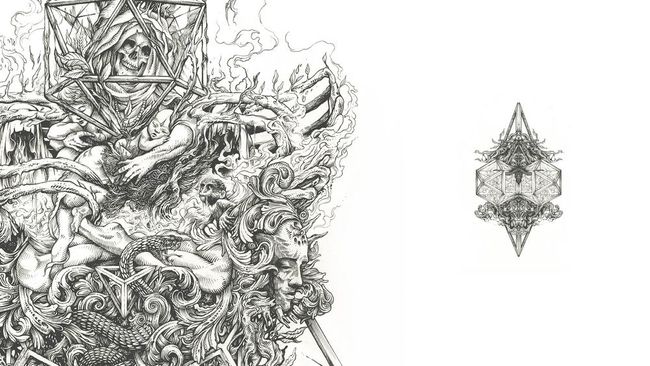
This style of dark illustration is what drives a lot of my work and I hope to achieve this feeling that this artist creates.
This is my first moving piece
 ‘Hi. I thought I’d start by showing you my latest completed piece ‘A Black and White view of the World’.
‘Hi. I thought I’d start by showing you my latest completed piece ‘A Black and White view of the World’.
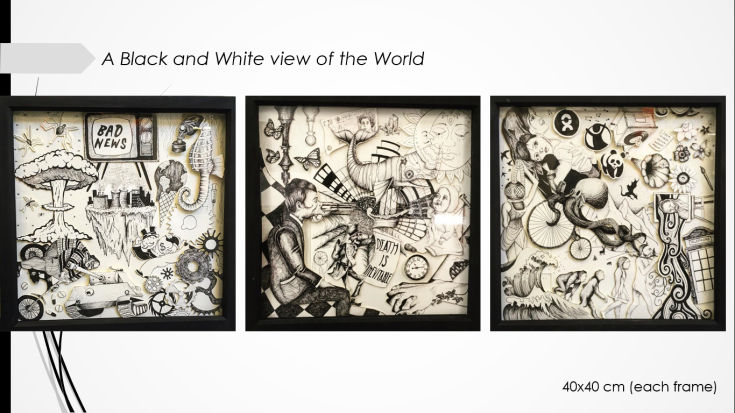 ‘These are shadow boxes. Different layers of illustration are spaced from front to back of the box-frames, creating depth and adding another dimension. I have used pen and ink in a surrealist style’.
‘These are shadow boxes. Different layers of illustration are spaced from front to back of the box-frames, creating depth and adding another dimension. I have used pen and ink in a surrealist style’.
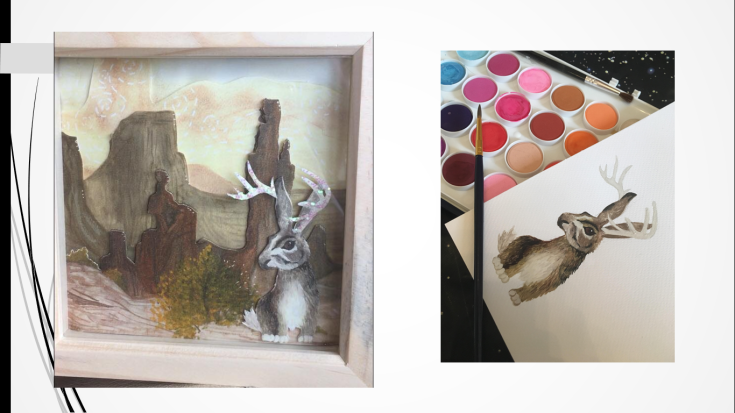
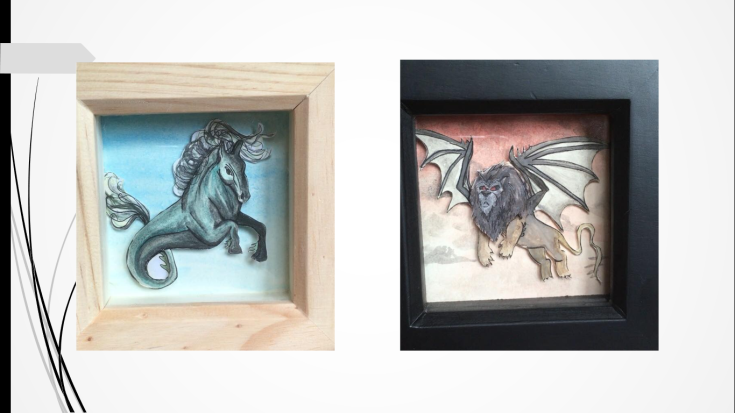 ‘These were my first ever attempts at shadow-boxing. its a bit difficult to see in an image, but I painted each layer individually and raised each one higher with foam pads. Although I enjoyed the effect of the box, the content wasn’t resonating enough with me.
‘These were my first ever attempts at shadow-boxing. its a bit difficult to see in an image, but I painted each layer individually and raised each one higher with foam pads. Although I enjoyed the effect of the box, the content wasn’t resonating enough with me.
All of my previous work has been about mental illness and the personification of it. I wanted to incorporate this into a shadow-box format. I decided to focus on one particular illness’.
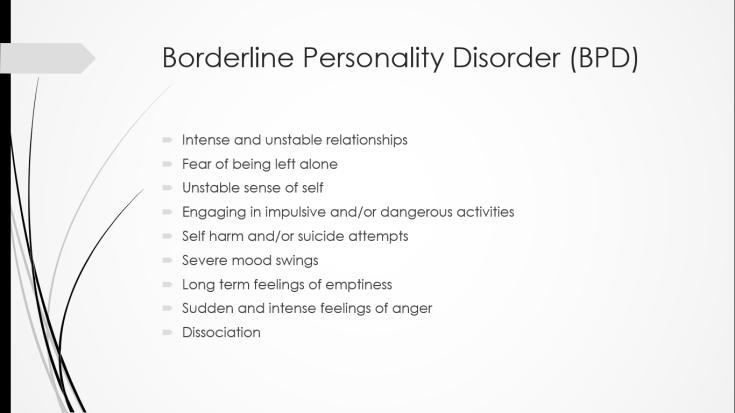 ‘Borderline Personality Disorder (BPD), also known as unstable personality disorder, is a chronic mental illness defined by long-term patterns of abnormal behaviour characterised by unstable relationships, unstable sense of self and unstable emotions (On the board is the 9 criteria that need to be met for a diagnosis).
‘Borderline Personality Disorder (BPD), also known as unstable personality disorder, is a chronic mental illness defined by long-term patterns of abnormal behaviour characterised by unstable relationships, unstable sense of self and unstable emotions (On the board is the 9 criteria that need to be met for a diagnosis).
My interest in this comes from personal experience as well as psychological curiosity. it has always fascinated me how different each persons perception of reality is. As well as how much mental illness can warp reality’.
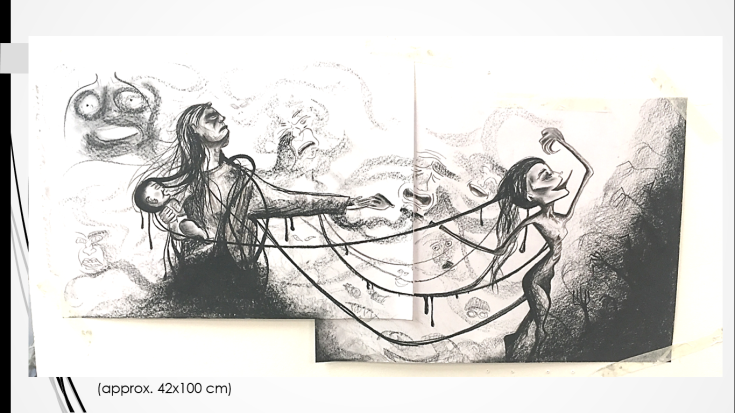 ‘This is my first BPD sketch. I’ve always found images better explain something- as well as helping mw make sense of them.
‘This is my first BPD sketch. I’ve always found images better explain something- as well as helping mw make sense of them.
This is a drawing of the words you just saw on the last slide, and although they’re both saying the same thing – I think the drawing is much more scary.
What you’re seeing is three personalities struggling to co-exist amongst a plethora of emotions and hurt.
At this point I already knew I wanted to explore shadow-box art- but I needed to get this on paper before I exploded.
I Spoke to Angus about shadow-box art, he suggested looking at toy theatres’.
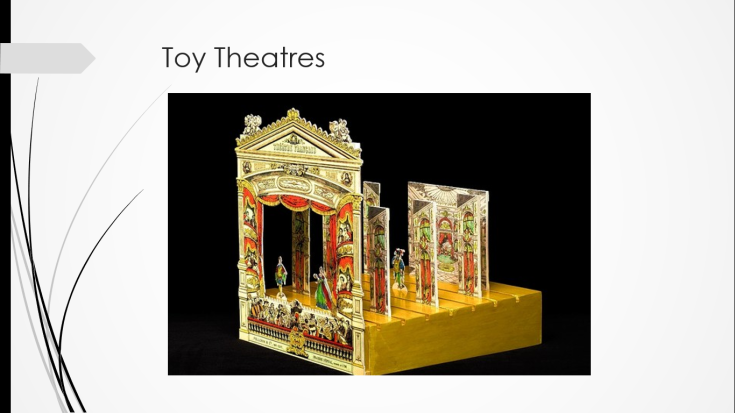 ‘Toy theatres were primarily around in Victorian times, and gave me the idea to take shadow-boxing a step further’.
‘Toy theatres were primarily around in Victorian times, and gave me the idea to take shadow-boxing a step further’.
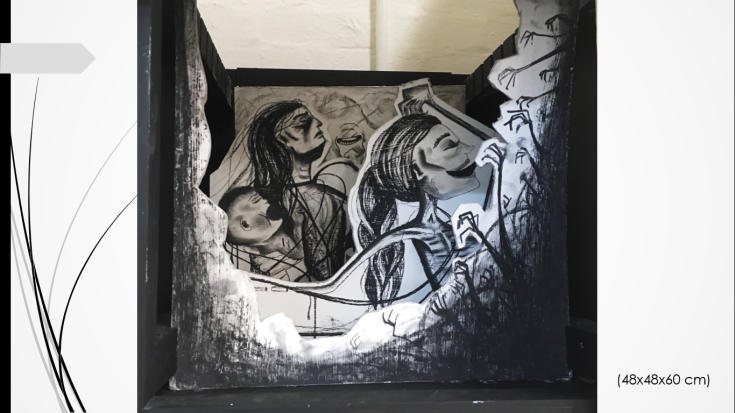 ‘And so I transformed my original sketch into a deep shadow-box piece. Although overall I consider this to be a successful piece, it wasn’t what I had envisioned.
‘And so I transformed my original sketch into a deep shadow-box piece. Although overall I consider this to be a successful piece, it wasn’t what I had envisioned.
I think making my first box 60cm deep was slightly too ambitious- so I started to look at artists who have done shadow-boxing in the past’.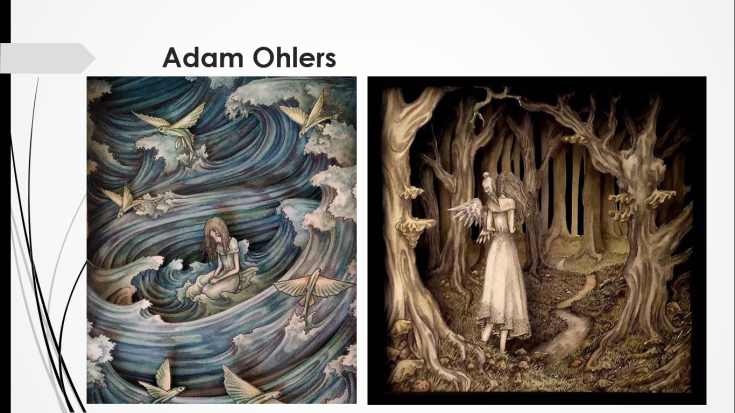 ‘I saw this artist on Instagram and is one of the reasons I wanted to try shadow-boxing myself. He has a very illustrative style as well as his beautiful, surrealish compositions’.
‘I saw this artist on Instagram and is one of the reasons I wanted to try shadow-boxing myself. He has a very illustrative style as well as his beautiful, surrealish compositions’.
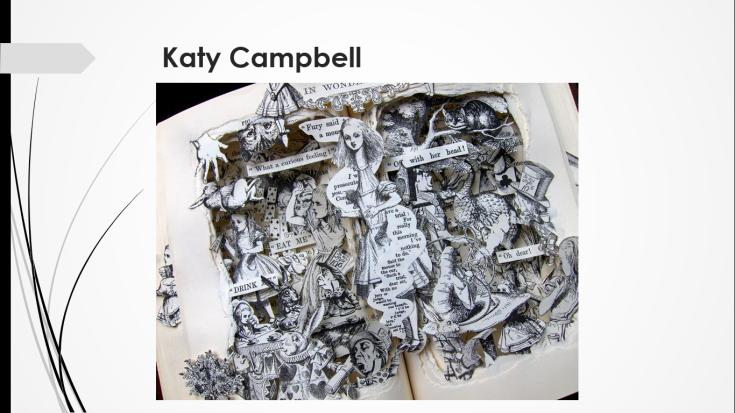 ‘Katy Campbell can be seen in the first piece I showed you ‘A Black and White view of the World’. I enjoy the way she cuts out the illustrations of a book to tell the story in a different way. Story telling has always been apart of my own practise’.
‘Katy Campbell can be seen in the first piece I showed you ‘A Black and White view of the World’. I enjoy the way she cuts out the illustrations of a book to tell the story in a different way. Story telling has always been apart of my own practise’.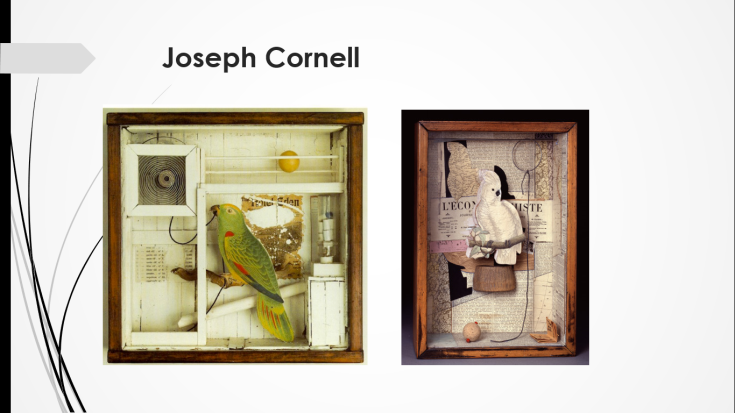
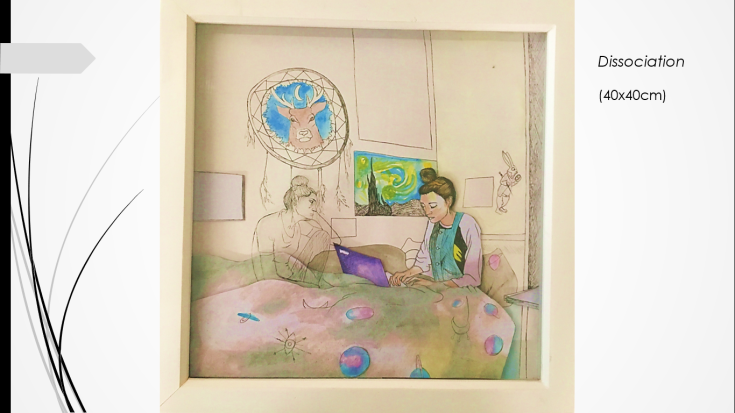
‘This was the next piece I did. I tried watercolour in this one and a much shallower shadow box.
Dissociation is a common phenomenon experienced by people with BPD. It happens when emotions get too overwhelming, the body goes into protection mode and can feel like an out-of-body experience.
I also had to get creative with materials in this one. I settled for transparent plastic for the consciousness, so that it is both there and isn’t.’
‘Which brings me back to this piece’
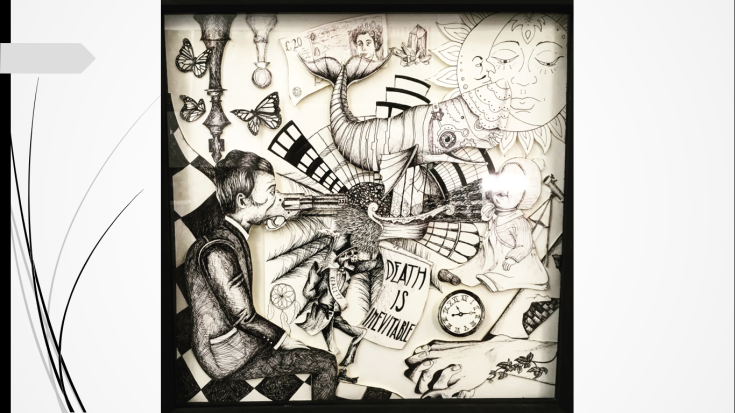 ‘In this one I wanted to portray what the world looks like through the eyes of a BPD sufferer. Often, they see the world in black and white- good or evil.
‘In this one I wanted to portray what the world looks like through the eyes of a BPD sufferer. Often, they see the world in black and white- good or evil.
I had so many more ideas for this piece that I decided to turn it into a tryptic’.
 ‘The left frame is entirely bad thing, and the right is just good. At first glance they may look quite similar, but I wanted the content to be contrasting as possible.
‘The left frame is entirely bad thing, and the right is just good. At first glance they may look quite similar, but I wanted the content to be contrasting as possible.
When I showed Angus, he said they reminded him of Victorian picture books’.
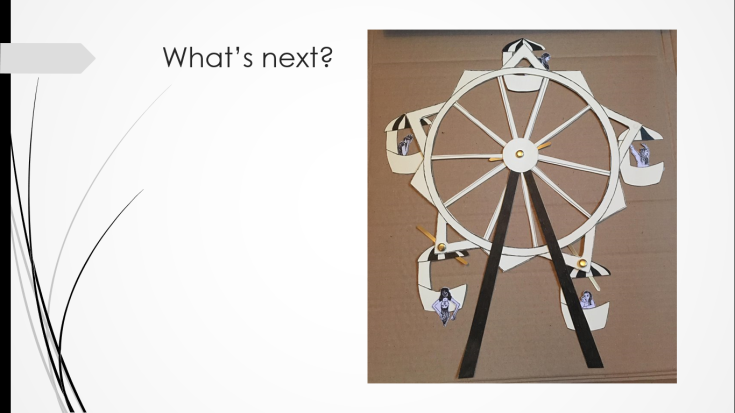 ‘So that’s where I’m going next. I am currently working on a piece in which the viewer will be able to interact with the drawing. this will be displayed in a shadow-box frame, with a mechanism on the outside which the viewer will be able to turn the ferris wheel themselves. Making them apart of the art. The people in the cars represent different personalities, and the spinning wheel represents the constant highs and lows of BPD’.
‘So that’s where I’m going next. I am currently working on a piece in which the viewer will be able to interact with the drawing. this will be displayed in a shadow-box frame, with a mechanism on the outside which the viewer will be able to turn the ferris wheel themselves. Making them apart of the art. The people in the cars represent different personalities, and the spinning wheel represents the constant highs and lows of BPD’.

 I decided to exhibit my tryptic ‘A Black and White view of the World’ in St. John’s Parish hall.
I decided to exhibit my tryptic ‘A Black and White view of the World’ in St. John’s Parish hall.
This decision was based on the fact that the hall is used for all manner of community events so will host every type of person. Whereas the art department and night club only attract a certain type of person. My piece is about mankind as a whole, the world in every light- so I thought this location was the most appropriate.
I displayed outside the main hall in the corridor. The hall was more isolated as well as being black and white- matching my piece.

3rd year have been put in charge of curating and hosting an exhibition. We have organised 3 locations to exhibit, UOR Art Department, St Luke’s Parish Hall and After Dark night club.
I am apart of the documentation committee, so will be part of filming the event, and making sure everyone has documentation of their work.



 with the steampunk type style, and the ideas people gave me about what they liked about the world, as well as my own perception of course- I have created the second piece of the tryptic.
with the steampunk type style, and the ideas people gave me about what they liked about the world, as well as my own perception of course- I have created the second piece of the tryptic.
The creativity, love, passion, kindness, weirdness, cleverness- that’s what I tried to capture in a surreal style that’s still a bit all over the place.
My favourite piece so far has been ‘A Black and White View of the World’. I also had many more ideas for this piece, so I decided to make it into a tryptic.
The original piece is a BPD way of seeing the world, good, bad, with no in between. I’m planning to make two more: one of just good, another of just bad- and have the original in the middle.
I have been asking around for ideas about people’s favourite thing about mankind, and people’s least favourite. 



 Dissociation is a common phenomenon experienced by people with personality disorders. It happens when emotions are to overwhelming, the body goes into protection mode and can feel like an out-of-body experience.
Dissociation is a common phenomenon experienced by people with personality disorders. It happens when emotions are to overwhelming, the body goes into protection mode and can feel like an out-of-body experience.
I used see-through pvc material to represent the consciousness.
 A black and white view of the world is a representation of how sufferers of bpd see the world. Of good and evil, black and white, no grey no middle. Everything in the drawing has a counter. Reality, has the counter of imagination, industry versus nature.
A black and white view of the world is a representation of how sufferers of bpd see the world. Of good and evil, black and white, no grey no middle. Everything in the drawing has a counter. Reality, has the counter of imagination, industry versus nature.
The Victorian style came naturally and I think works effectively.
After talking to Angus he said it reminded him of Victorian picture books, the children’s books that are interactive, that move when you pull on a tab etc.